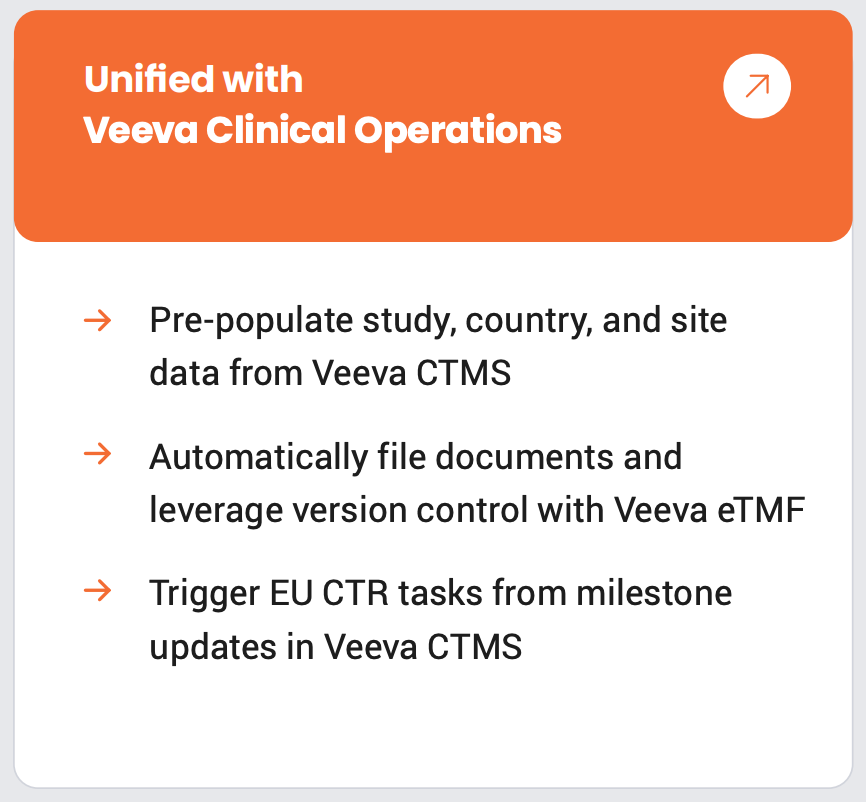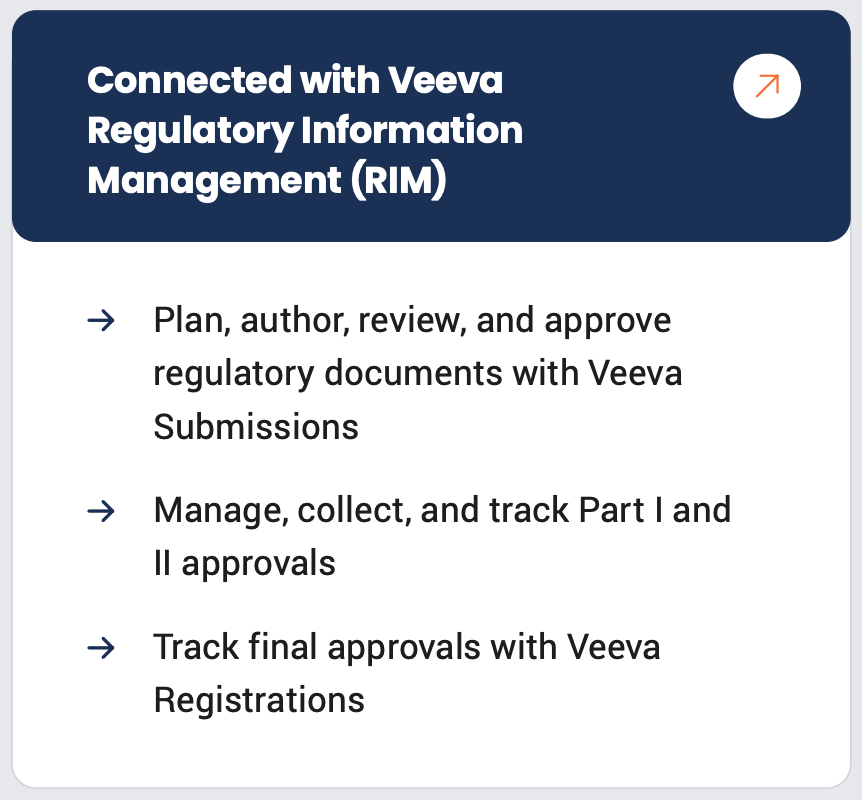White Paper
Streamlining Clinical Trial Disclosures
to Manage EU CTR Complexity
Proper clinical trial disclosure is essential to complying with the European Union Clinical Trials Regulation (EU CTR) and ensuring trial success. Although the regulation aims to standardize processes and improve trial efficiency, it can also lead to increased workloads, data accuracy concerns, and inefficiencies caused by fragmented systems. This whitepaper explores how adopting a centralized solution like Veeva Disclosures can help simplify EU CTR processes.
The Impact of EU CTR
EU CTR fosters research by streamlining trials across the EU and EEA. It introduces a single application process via CTIS (Clinical Trials Information System) for better transparency and safety.
EU CTR seeks to foster research and innovation by making it easier to conduct clinical trials in the EU and surrounding European Economic Areas (EEA). A key component of the regulation is simplifying disclosure processes by allowing sponsors to submit a single application through the Clinical Trials Information System (CTIS). Then, regulatory authorities responsible for assessing and overseeing trial conduct review the application to ensure the highest standards for participant safety and trial transparency.
TRANSITION TO CTIS
EU CTR took effect on 31 January 2022, with a three-year transition period, repealing the Clinical Trials Directive (CTD).
31 JAN 2022 – 30 JAN 2023Sponsors could apply to start a new trial in CTIS or CDT’s registry, EudraCT; ongoing trials could remain in EudraCT
31 JAN 2023 – 30 JAN 2024Sponsors were required to submit all new trial applications in CTIS; ongoing trials could remain in EudraCT
31 JAN 2024 – 30 JAN 2025All trials must comply with EU CTR; sponsors must transition all ongoing trials to CTIS
Challenges with EU CTR disclosure submissions
Disclosure teams transitioning to EU CTR encounter several key challenges, including:
- Increased workloads: EU CTR’s requirements for data privacy, collection, standardization, and data quality increase the volume of required disclosure tasks. As companies become more familiar with CTIS, they will have to meet training requirements that may result in increased administrative work to upload data and documents.
- Data accuracy concerns: Without a source of truth or version-control capabilities, duplicate trial records and data discrepancies are rampant across clinical systems. These data quality and accuracy concerns force sponsors to reconcile and standardize inconsistent data formats from various registries before transitioning the data to CTIS.
- Inefficiencies from fragmented systems: Most teams rely on disconnected disclosure solutions that require manual entry or integrations to aggregate information across clinical applications. When using fragmented systems, manually transferring country and site data while tracking the status of milestones and required documents leads to inconsistencies and delays. Plus, building and maintaining integrations that require duplicative effort is inefficient, labor-intensive, and complicates submission management.
A streamlined approach to clinical trial disclosures
Veeva Disclosures is a flexible, configurable solution that centralizes clinical trial disclosures, accelerates submissions, and ensures EU CTR compliance. The application facilitates registrations and results disclosures with CTIS, and notifies study status by country – simplifying the process from preparation to submission. By leveraging information from both clinical and regulatory systems, Veeva Disclosures eliminates the need to build and maintain third-party integrations. This ultimately accelerates trial execution and improves visibility.
Enabling data reuse without integrations
Centralizing data in Veeva Disclosures creates a seamless flow of information across systems. Unified clinical applications enable information reuse, automatically pre-populating data from Veeva CTMS and tracking the status of documents required for submission in Veeva eTMF.
Connectivity streamlines access to product data from Veeva Regulatory Information Management (RIM), decreasing the risk of non-compliance due to redundant information. A centralized approach to disclosures provides visibility across regulatory and clinical systems and promotes collaboration to simplify end-to-end EU CTR processes.
Facilitating data preparation and submission
Fast and accurate disclosure preparation and submission improves trial efficiency and effectiveness. Veeva Disclosures generates disclosures with pre-configured registry rules and applies country intelligence to calculate due dates. It automates data reuse by pre-populating information from other clinical systems and triggers registry updates based on changes in study data.
Simplifying end-to-end clinical trial disclosure processes
Process efficiency also accelerates preparation and submission. Configurable workflows, collaborative document authoring, and user management enhance agility, while reports and dashboards deliver actionable insights. Upon finalizing Part I and II data, disclosure teams can generate CTIS documentation that flows seamlessly into Veeva Submissions, streamlining the disclosure process from start to finish.
Overcoming EU CTR challenges with Veeva Disclosures
A complex regulatory landscape and vast amounts of data complicate clinical trial disclosures. Other point-to-point disclosure tools require manual entry and resources to build and maintain integrations. By leveraging unified and connected clinical and regulatory systems, Veeva Disclosures provides comprehensive visibility into EU CTR processes that improve compliance and accelerate drug approval timelines.
See how unified systems simplify and centralize clinical trial disclosure management.
